You are currently browsing the monthly archive for January 2012.
I originally planned to continue the last post by discussing the math battle problem in Episode 1, but I think it’s mostly sufficiently explained in the episode already, though there are some logical holes: Sayuri’s first “proof” isn’t really a proof, and not really an argument either. It just sets up part of the geometry, which Nina extends to actually derive something. The whole thing also relies a bit too much on assumed accuracy of measurements, I think, which I don’t really buy, but once you get past the assumption, things are sound. If you’d like more explanation, however, I can write up something on it.
I also refer you to Prettycatchy’s video explanation:
Instead, in this post, I’ll discuss (and solve) the seven problems posed to Kazuki in Episode 2. In context, they’re presented in reverse order of difficulty, from university-level to lower-middle-school-level, and only the last problem is explained. I’ll go through all of them in order.
- Prove that when 0 < x < π/4, the integral of cosine t from 0 to x is greater than twice the integral of sine t from 0 to x.
In mathematical notation, the inequality to be proven is
Each side is a definite integral, which gives you the area of the region underneath the curve given inside the integral (or the negative area when the curve is below the horizontal axis). In this case, we have t as the independent variable of the function inside the integral, instead of x as is usually the case (since x is the independent variable of the entire expression). The left-hand side is the area of the region bounded by the t-axis, the curve
, the vertical line
and the vertical line
. The right-hand side is the same except the curve is
and you multiply the resulting area by 2. So the inequality states that the gray area is strictly larger than twice the orange area, as shown in the two graphs below:
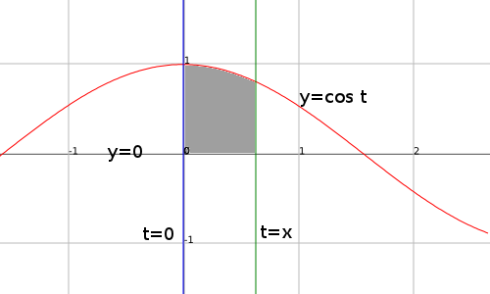

You can evaluate a definite integral by finding the antiderivative and taking the difference of the antiderivative evaluated at the upper point and the antiderivative evaluated at the lower point. The antiderivative of
is
, and the antiderivative of
is
. Doing this and simplifying results in an equivalent inequality:
So if we prove this is true for
, we prove the original inequality.
Let
.
You can plot
over that interval and see that it’s always greater than 1:
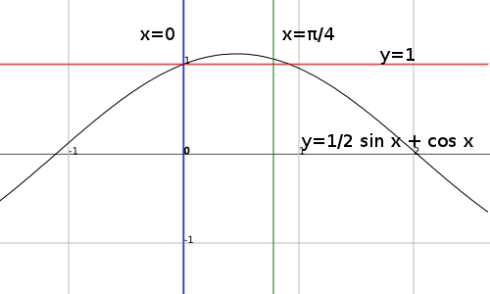
But arguing by graph isn’t a foolproof method (and isn’t feasible to do by hand), so let’s do this analytically. We can do a proof by contradiction: we suppose that there is a point q in
such that the inequality does not hold (that is,
), and show that this leads to a contradiction.
We can now use the mean value and intermediate value theorems to prove that if such a point q exists, then there must be two distinct points in
where the derivative (the slope of the line tangent to the curve at a given point) is 0, which we will show is a contradiction.
We start by checking the coordinates of the endpoints of the interval:
For the first endpoint,
is 1, but since 0 is not itself part of the open interval
, this is not a problem. The right endpoint is greater than one (this can be easily verified by hand by squaring both sides), so it is also consistent with the inequality. Next, we compute the derivative and evaluate it at the endpoints:
So the derivative at 0 is positive, and the derivative at π/4 is negative.
If we connect the left endpoint
and
by a straight line, the slope of the line is
Since
and
, the slope is either zero (if
) or negative. By the mean value theorem, since f is continuous and differentiable (a property of all sinusoids), there must exist a point p in
such that the derivative at p is equal to this slope. So
.
Next, we connect
to the right endpoint
by a straight line. The slope here is
Since
and
, their difference must be positive.
is also positive, so the slope here is positive. Again, by the mean value theorem, this means that there is a point r in
such that
.
We now have constraints on the derivative at the two endpoints as well as some points p and r within the interval.
Since
, this means the value of
goes from positive to zero/negative to positive to negative.
The intermediate value theorem tells us that since
is continuous, for any closed interval
, for every d in
(assuming
; switch the two otherwise), there exists a point c in
where
. This means that any interval
where a is positive and b is zero/negative, or vice versa, must contain a point c where
.
So there must be a point u in
such that
, a point v in
such that
, and a point w in
such that
. Since these are closed intervals with overlapping endpoints, it is possible for u and v to be identical. It is not possible for u and w to be identical, however, since p is strictly less than r.
This shows that there are two distinct points u and w in
whose derivative is 0.
We will now show that this contradicts the properties of the particular f we have. Let us solve for any points c in the interval
with a derivative of 0:
The tangent function is one-to-one in the interval
, so there is at most one c in
such that
. (We can can quickly prove the one-to-one property analytically. First, the tangent function defined for all points in this interval, since the cosine of all points in this range is nonzero. Suppose it’s not one-to-one; then there must be two distinct points m and n in
such that
. This means the slope of the line connecting the two points is 0, so by the mean value theorem, there is a k in
such that the derivative of the tangent function is 0. The derivative is
, which is always positive, so there is no such point.)
Our assumption that there is a point q in
where
leads to the conclusion that there are two distinct points meeting this condition, so there is a contradiction. Therefore, the assumption is not valid, so there is no such q.
So for all points x in
,
. This proves the desired inequality.
- Find the volume V of a regular octahedron with side length a.
A regular octahedron is a polyhedron with 8 faces (each one an equilateral triangle) and 12 sides of equal length. We can compute the volume by splitting the octahedron into two pyramids of equal volume, finding the volume of one of the pyramids, and multiplying by 2.
Let’s look at one of the pyramids. We can compute the volume
, where B is the area of the base, and h is the height. In the figure below, each of the edges is of length a, the height is h, and the diagonal of the square base is d:
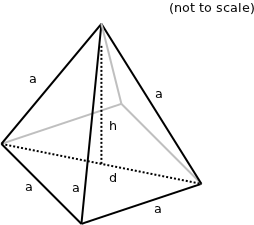
The area of the square base is
. To determine the height h, we can take a cross-section along one of the diagonals. This yields a triangle formed from two of the sides of the octahedron and the diagonal of the square:
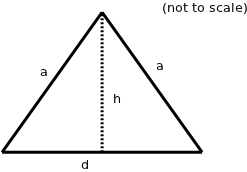
The diagonal has length
. Since two of the sides have the same length, we can divide the isosceles triangle into two right triangles. This yields a triangle with one of the octahedron’s sides as the hypotenuse and two legs: one is half the diagonal of the base square, and the other is the height of the pyramid.
We can use the Pythagorean theorem to relate these:
Multiplying to get the volume of the entire octahedron, we have:
- Find a vector c of length 1 orthogonal to both vector a = (5, 7, 3) and vector b = (7, 6, 5).
One can compute the cross product of two linearly independent vectors to get a vector orthogonal to both.
There are several ways to compute the cross product. One is to make a 3×3 matrix out of the standard basis vectors i, j, and k in the first row and the two vectors in the second and third rows, and then compute the determinant of this matrix. In this case we have
We can break this into three smaller determinants via Laplace expansion:
Then we can easily compute each of the three determinants by multiplying the main diagonal elements and subtracting the product of the other two elements:
So the cross product is
.
But we’re not done yet. The problem wants an orthogonal vector of length one, so we have to normalize the cross product. We can compute the magnitude of the cross product by squaring each component, adding, and taking the square root:
We can divide each of components of the cross product by the magnitude to produce a vector pointing in the same direction with length 1:
There are two possible answers, actually. The vector can point in the same direction as the cross product, as given above, or it can point the opposite way. Either of these is acceptable:
- Find the radius of the inscribed circle in triangle ABC, where AB = 5, BC = 7, and CA = 3.
The circle inscribed in a triangle is the circle that is tangent to all three sides of the triangle:
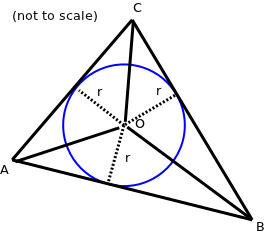
Here we have triangle
with the inscribed circle at center O with radius r. The triangle can be partitioned into three triangles
,
, and
.
The area of each of the triangles is equal to half of the radius r times the length of the edge tangent to the circle.
The area of the entire circle can be found by using Heron’s formula:
where s is the semiperimeter:
For the triangle given in the problem, we have
The total area is equal to the sum of the areas of the three smaller triangles:
Set these equal to each other and solve for r:
- Find the smallest positive integer n such that 765n is a square number.
A square number is an integer whose square root is also an integer. This requires that each prime factor of the number have an even multiplicity, so that you can divide the factors into two identical groups, each of them multiplying to form the square root.
So for 765n to be square, each of the factors in its prime factorization must appear an even number of times. Since we don’t know what n is yet, we can do it just for 765 (factorization in general is a hard problem, but this one can be done by hand easily, once you observe that it’s a multiple of both 3 and 5):
3 already appears twice, but 5 and 17 each appear once. Therefore n needs to have an odd number of occurrences of 5 and 17 for 765n to be square. Since we want the smallest positive integer that works, we can just multiply 5 and 17:
- Solve the system of equations 5x + 7y = 3, 7x – 6y = 5.
Sayumi’s favorite pastime, solving systems of equations!
This can be done using several methods, but some form of Gaussian elimination is probably the most fun.
To do so, we take the system of equations and put the coefficients in an augmented matrix, with the right-hand values in a column on the right:
We divide the first row by the leftmost element, 5, to get a 1 in the upper left:
Then we subtract 7 times the resulting first row from the second row, to put a 0 in the lower left corner:
Now we divide the second row by -79/5 to get a 1 there as well:
Finally we subtract 7/5 times the second row from the first row to get an identity matrix:
This translates back into
, which is our solution.
- The time is 3:00. Between 3:00 and 4:00, what hour, minute, and second will the minute hand and the hour hand overlap exactly?
This was sufficiently explained in the episode, I think, so I won’t discuss it in detail. The idea is to determine the angular velocity of the minute hand and the hour hand (6°/min and 0.5°/min, respectively), find their relative difference (5.5°/min), and divide the initial angular displacement (90°) by this relative velocity to get the time it takes for the hands to overlap, which is 16 and 4/11 minutes. 4/11 of 60 seconds is 21.8181… seconds, or approximately 22 seconds. So the time would be 3:16:22.
Prettycatchy has another video explanation here:
With those 7 problems solved, I look forward to seeing what awaits us in the next episode!! (^_^)
I’ve been a bit slow in responding to the new math drama Suugaku♥Joshi Gakuen starring a whole bunch of H!P members, but now that the first episode is out, here’s a post.
H!P math drama??!!! I’ve been waiting for this my whole life! (Never mind that my life predates H!P.) And of course I’m happy to see Sayu starring as a math geek, given the interest she’s expressed in the subject.
I don’t have time right now to do a full review of the first episode, but I’ve found it quite awesome so far, with respect to the geekiness, though the number of typos I’ve spotted have been quite a distraction. The series has apparently been developed in cooperation with the Mathematical Olympiad Foundation of Japan, so the math is essentially correct, as far as I can tell so far (I haven’t dissected most of it yet), though the editing work seems to have been rather sloppy.
Also, I’m not sure who’s planning to fansub this drama, but I would like to volunteer as a math consultant. So if you are working on this, please sign me up. I think the kinds of mistakes that have slipped through the editing can also pop up in translation, and I can help look over the translations and correct any possible math errors.
Here are some typos (and non-typos) I’ve found:
The first equation is given as . This says that the limit of f(x) as x approaches a is equal to a. As written, this is only correct for all values of a if f is the identity function. This should probably be
, which is true for all continuous functions.
The second equation says . There is an extra equal sign here. It should be
. This is the derivative of ax respect to x.
The third equation is fine as is, and expresses linearity of integration.
This clock is just awesome. It has expressions evaluating to or otherwise indicating each of the integers from 1 to 12, which we would see on a normal clock.
-
— the tangent of 45°, equal to 1.
-
— this is a typo; should be
, an infinite series converging to 2.
- 3i — this is another typo; should be 3, an HTML code for the character 3.
-
— the modular multiplicative inverse of 2 (mod 7); 4 and 2 multiply to 8, which is congruent to 1 (mod 7), so 4 is an inverse of 2 (though not the only inverse; 11 is the other integer on the clock that satisfies this property, which makes this a flawed clock).
-
— solve for X, which can be either 5 or -5.
-
— the factorial of 3, which is 6.
-
— this repeating decimal is equal to 7.
-
— the square root of 64 is 8.
-
— since π is irrational, this is actually 9.004777960769…, but it’s approximately 9.
-
— solve for X, which is 10.
- 0x0B — hexadecimal for 11, with the standard hexadecimal prefix of “0x” used in Unix-like shells and C.
-
— the cube root of 1728 is 12.
This is given as , but the radical should extend over the entire right-hand side:
.
In context, Nina (Reina’s character) swings on a rope into the classroom. This expresses her velocity at the lowest point of her trajectory.
Nina starts out with a gravitational potential energy of mgh (m is mass, g is gravitational acceleration, and h is height, measured relative to the lowest point of her trajectory) and no kinetic energy prior to swinging on the rope. At the lowest point, she has a kinetic energy of (m is mass and v is velocity) and no potential energy. Due to conservation of energy, these two are equal:
It seems Tsunku♂ has joined the eminent ranks of Napier, Fermat, Gauss, Cauchy, Lagrange, et al…. :o

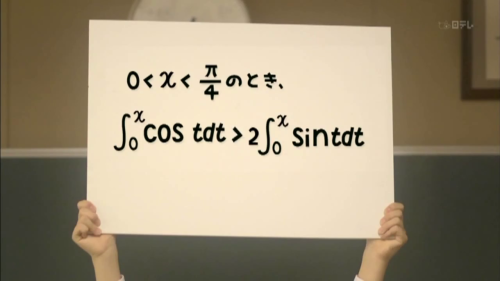

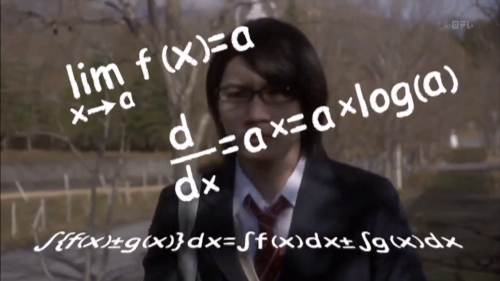
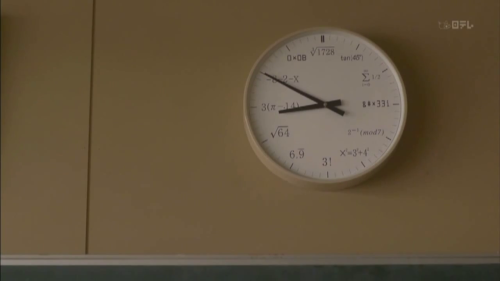
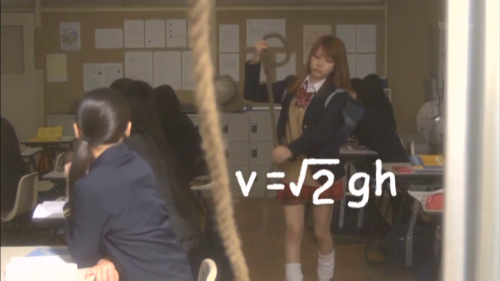
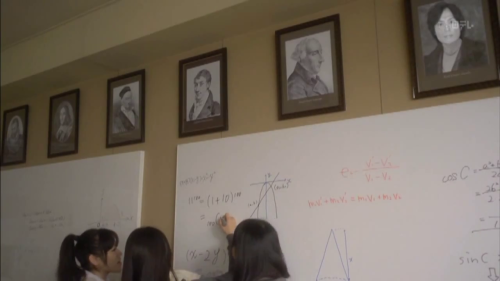

Recent Comments